Some people go to the gym just to look good, and that’s a fine goal to have. They spend time and effort working various muscle groups to improve their aesthetics and reach their dream physique. Yet, some body parts aren’t always given the same attention as others. Let’s be real. The calves are commonly ignored. … Read more
The post How to Do the Standing Calf Raise for Complete Leg Development appeared first on Breaking Muscle.
Some people go to the gym just to look good, and that’s a fine goal to have. They spend time and effort working various muscle groups to improve their aesthetics and reach their dream physique. Yet, some body parts aren’t always given the same attention as others.

Let’s be real. The calves are commonly ignored. That’s a shame, because not only do muscular calves contribute to a well-balanced, eye-pleasing physique, but they also support optimal knee and ankle health and performance. And what more simple exercise than the standing calf raise to develop this muscle group? Let’s take a look at this effective exercise, and learn how and why it should no longer be overlooked.
- How to Do the Standing Calf Raise
- Standing Calf Raise Mistakes to Avoid
- Benefits of the Standing Calf Raise
- Muscles Worked by the Standing Calf Raise
- Who Should Do the Standing Calf Raise
- How to Program the Standing Calf Raise
- Standing Calf Raise Variations
- Standing Calf Raise Alternatives
- Frequently Asked Questions
How to Do the Standing Calf Raise
The standing calf raise is a pretty straightforward movement, but it’s certainly possible to have problems with performance. Let’s cover proper use of this machine to deliver complete calf development.
Step 1 — Get Into the Starting Position
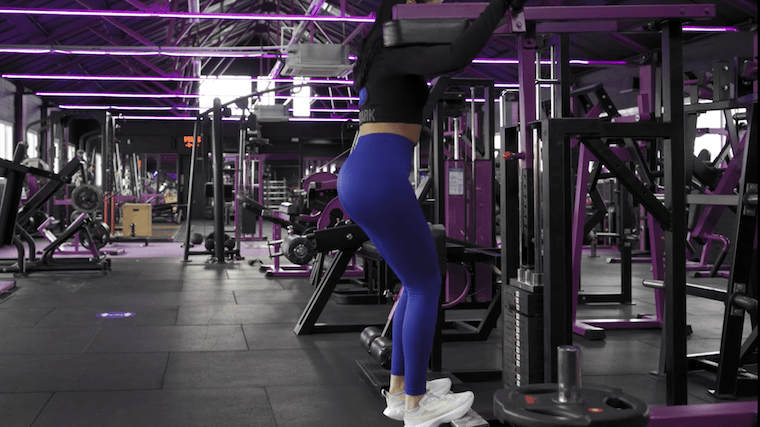
Set your feet roughly shoulder-width apart on the block or step. Only the front halves of your feet should be on the step. Your heels should be hanging in the air. Keep your balance by holding the shoulder pads or support handles. Make sure your hands stay away from the weights and any moving parts.
Keep your knees bent and your back straight as you place your shoulders under the pads. Stand tall by pushing into the balls of your feet and straightening your knees. Keep your core tight to maintain a straight back.
Form tip: Adjust the shoulder pad height so you can stand upright with additional room to perform a full range of motion calf raise. When standing tall, you should be able to rise onto your toes while keeping a straight line from your shoulders to your feet. If you have to hunch over or bend your knees, the exercise won’t be as efficient.
Step 2 — Push Through the Balls of Your Feet
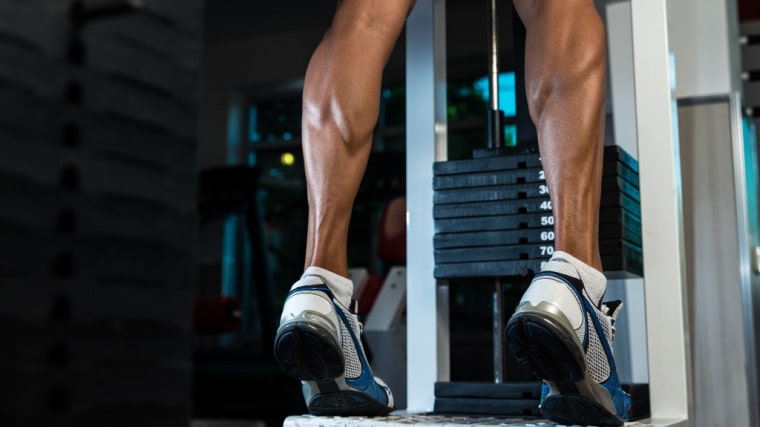
Push through the balls of your feet to raise your heels as high as possible. Keep your legs straight to prevent larger leg muscles from helping. Pause for one second at the top and flex your calves as much as possible. Keep your upper body stable. Resist any urge to shrug your shoulders while your feet move.
Form tip: Completely extend your ankles, pushing all the way to the top. The range of motion is relatively limited on this exercise because the ankle is a relatively small joint. Don’t reduce the range of motion further by stopping before your calves are fully contracted.
Step 3 — Lower Your Heels Slowly
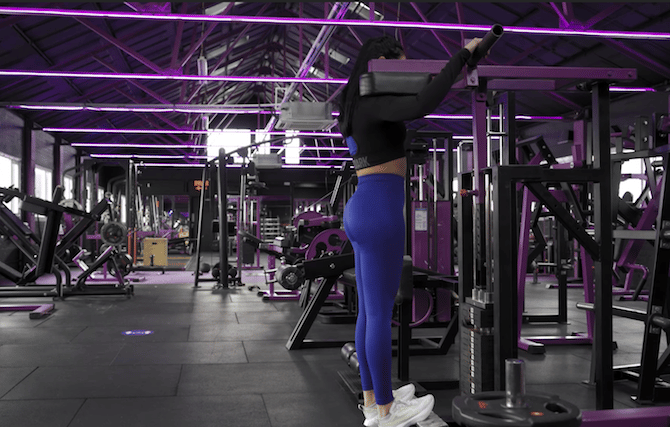
Let your heels sink slowly towards the ground, dorsiflexing your foot (letting your heels drop below your toes). Your calves should be in a fully stretched position.
Stay in the stretched position for a second to prevent rebounding or momentum before repeating for additional repetitions.
Form tip: The stretch is an important component of calf growth, so don’t be afraid of feeling a stretch in the bottom position. However, some people lack ankle mobility and have limited range of motion. To minimize the risk of injury, use a slow, controlled speed and avoid dropping quickly into the bottom position.
Standing Calf Raise Mistakes to Avoid
When it comes to building muscular calves, mistakes will stop muscle growth in its tracks. If you want gains, performing each repetition perfectly is of the utmost importance. Here are the most common errors to avoid.
Fast, Rebounded Repetitions
This is the ultimate calf training sin. You might be tempted to use the stretch reflex (rebound) and rush through fast-paced reps in order to lift more weight or make the set easier, but this will just result in eternally puny calves.
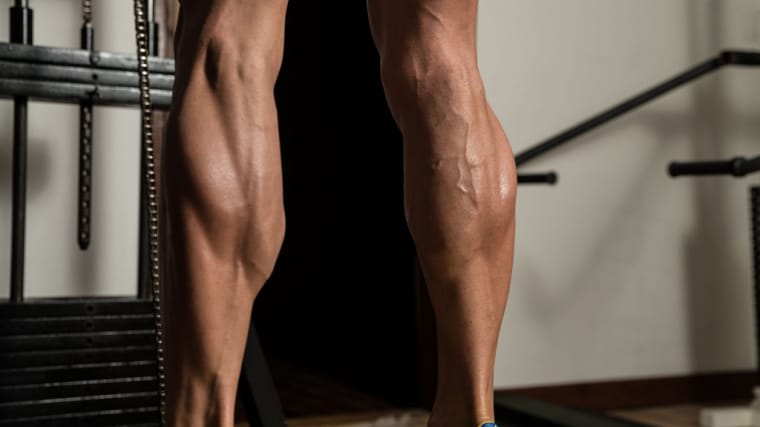
The exercise’s range of motion is relatively limited, so if you rush through each rep, the time under tension will be minuscule, resulting in poor growth. This is reinforced by the fact that the calves typically have a lot of type I muscle fibers which respond better to longer sets and more volume. (1)
Avoid it: For optimal muscle growth, slow down the repetitions and don’t shy away from using pauses at the top contraction or in the bottom stretched position.
Cutting the Range of Motion Short
Performing a full range of motion has been proven optimal for muscle growth, especially in the lower body. (2) As such, you have to make sure you go as low as your ankles will allow and flex as high as you can during each repetition.
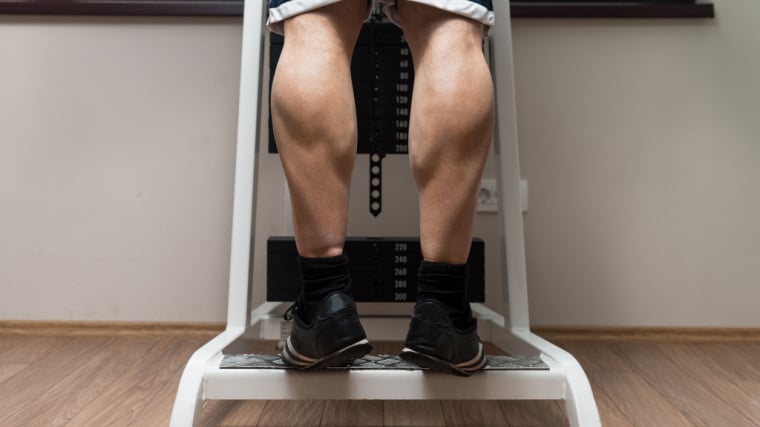
Short-changing the range of motion can be as bad for muscle growth as blasting through repetitions at warp speed. Calves can be a notoriously hard to grow muscle group. (3) If you want to progress, you will have to accept some muscle-building, muscle-burning discomfort, and ensure you squeeze the muscle through every possible fraction of an inch.
Avoid it: On every single repetition, sink as low as you can in the stretched position. Tension around your ankles will tell you when it’s far enough. Also, push through your toes and imagine your heels reaching the ceiling during the peak contraction.
Using Leg Drive to Move the Weight
Sometimes you can cheat the standing calf raise without even noticing, especially when going heavy. Leg muscles like the glutes and quadriceps are very strong and your body will instinctively “want” to use them to help move the weight, but that reduces the work done by the calves and reduces the muscle-building stimulus.
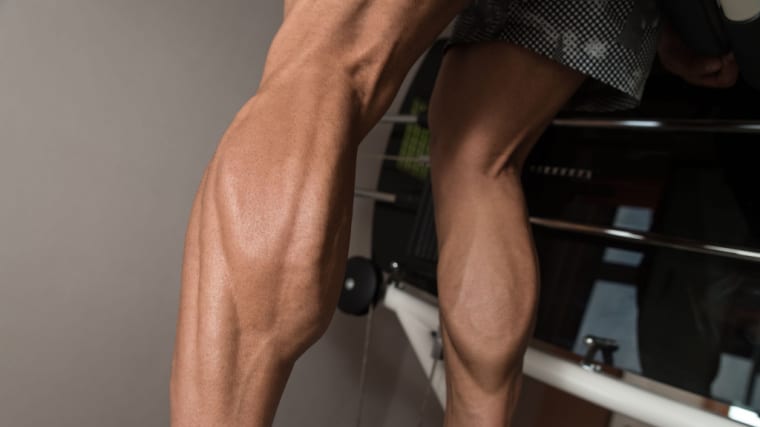
If your knees begin bending and straightening during the exercise, or if your body bends forward at the hips, you’ll be shifting focus away from the calves and onto other muscle groups.
Avoid it: Focus on a mind-muscle connection with your calves. Instead of just thinking about “lifting the weight up,” think about specifically pushing through your toes. Keep your body straight throughout the set and pay particular attention to your knees and hips.
Benefits of the Standing Calf Raise
Even though calf training is often overlooked, this exercise can find its place in most training regimens. Here are the most important reasons why.
Muscle Growth
The standing calf raise is one of the best lower leg exercises for hypertrophy. The standing position is an efficient way to target the gastrocnemius — one of the two heads of the calf muscle.
View this post on Instagram
Because of the muscle recruitment and potential time under tension, standing calf raise can bring a significant visual change to your calf development. If there’s only one calf exercise you could do, this would be top of the list.
Explosive Power
If you care about athleticism or sports performance, this standing calf raise actually help. Calf training helps you jump higher and more frequently by allowing your body to produce more force, absorb more force eccentrically (during landing), and reinforce tendon strength and total-body stability so you are more resilient.
The lower leg muscles have an active part in the ankles and knees functions. Every movement that mobilizes these joints — such as running, kicking, tackling, and jumping — will benefit from calf training. Strengthening your calves will help you be a more complete and efficient athlete.
Healthier, Stronger Ankles and Knees
Standing calf raises can eventually improve your ankle mobility by gradually stretching your calves. The calves will also increase in size and strength, resulting in more control and resilience over the ankle and knee joints. (4)
This carries over to everyday life, since many people are on their feet all day long. It’s especially relevant if you walk, run, or play sports that heavily involve your legs.
Muscles Worked By the Standing Calf Raise
The standing calf raise is considered a single-joint isolation exercise, because the only movement should be at the ankle joint. The movement focuses training stress on a single muscle group — the triceps surae, more commonly known as the calves, which are the main muscles in the lower leg.
Gastrocnemius
The gastrocnemius is one of two heads of the calf muscle. Sometimes shortened to “the gastroc,” it runs from the back of your knees to your ankles. The gastroc is the larger of the two calf heads and it’s the one you see the most.
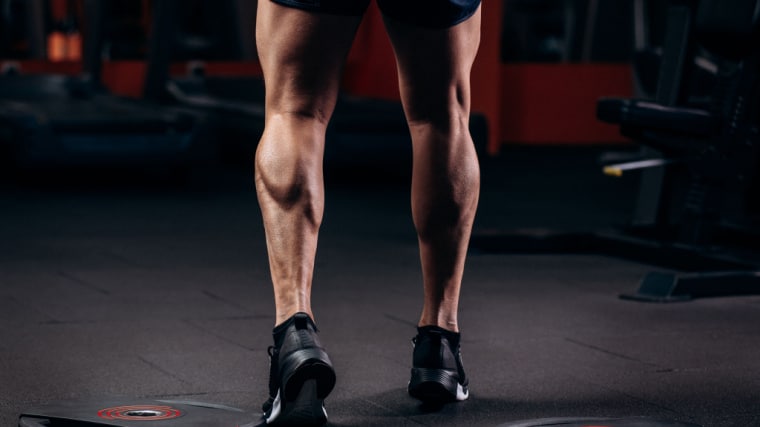
Its function is plantar flexion of the foot (extending the ankle and pointing the toes down). It also plays a role to assist your hamstrings when bending your knees. This is a muscle heavily involved in running, jumping, and walking.
Soleus
The soleus is the other head of the calf muscle. This deeper section is located between the gastrocnemius and the lower leg bones. This muscle is significantly involved in plantar flexion (lowering your toes below your heels). The soleus isn’t as big, but it is relatively powerful and it’s crucial for running, walking, and standing tall.
Who Should Do the Standing Calf Raise
Those who completely avoid calf training are sorely mistaken, especially if they want complete physical development. Many lifters should introduce this exercise into their training because it has more to offer than just hypertrophy.
Bodybuilders and Physique Athletes
If you’re interested in an aesthetic, symmetrical physique, you should never skip calves. In fact, in the early days of classic bodybuilding, lifters would aim to have their calves as big as their arms. The legendary Arnold Schwarzenegger supposedly “calf-shamed” himself by frequently wearing shorts, so the constant sight of his relatively small calves would be motivation to train them intensely.
Many people still overlook calf training but, along with your forearms, they are the most visible parts of your body most of the time. In any case, if you’re chasing aesthetics, you cannot avoid working any body part.
Strength Athletes
Calf training won’t directly carry to your big lifts, but it can actually be very valuable to strength athletes. Indeed, the calves help knee and ankle stability, and this is especially true of the soleus because it is more active when your knees are bent — like in the squat.
Moreover, calf training can also improve ankle mobility, which is critical for proper squat mechanics and overall lower body health. If you’re a strength athlete who’s experiencing knee pain, has trouble reaching squat depth, or is experiencing instability when lifting, you should give calf training a go.
Sports Athletes
In athletics, injury prevention is key. Directly training the calves can result in calf muscles that can withstand more shock while improving ankle mobility and resiliency — especially with respect to the Achilles tendon, a vulnerable part of any athlete’s body.
Athletes experience constant stress on the ankle and knee joints when changing direction, sprinting, and performing plyometric movements on or off the field. These activities can be some of the most potentially dangerous movements one can perform if their body’s support structures aren’t durable. As such, if you’re an athlete that cares about knee or ankle injury prevention, you should train your calves.
How to Program the Standing Calf Raise
Being an isolation exercise that targets a single muscle group, it makes no sense trying to go super-heavy with this exercise because it’s less efficient and other muscles will be recruited.
Moreover, calves typically react better to a longer time under tension and higher volume, because they have a high proportion of slow muscle fibers. They are best trained with moderate-to-high rep schemes.
Moderate Weight, Moderate Repetitions
This is a classic, proven hypertrophy scheme. Three to five sets of eight to 12 repetitions will work just fine. The weight should be as heavy as you can handle to the rep range, but not at the expense of form. You should be able to control the weight at all times, achieve a full stretch, and be able to contract maximally without compromising the range of motion.
Light Weight, High Repetitions
Going lighter for higher repetitions is a surefire way to scorch your calves if you have trouble feeling them, and can serve as a great finisher. Two to three sets of 15 to 25 repetitions, reaching muscular failure at the last repetition, is a great way to accumulate volume and grow your calves.
Tempo Work
If you’re a more seasoned lifter, spicing up your calf training can spark new gains and motivation. Calves are particularly responsive to tempo training — manipulating the speed of the lifting and lower phases of each repetition.
For unprecedented soreness and muscle stimulus, try a two-part approach with several sets emphasizing the stretched position followed by several sets emphasizing the contracted position. Two to three sets of 10 to 15 repetitions with a two-second pause at the bottom, followed by two to three sets of 10 to 15 repetitions with a two-second pause at the top of the contraction.
Going Beyond Failure
If you’re an advanced lifter, you might still need to crank up your calf training to the next level in order to progress. Warning: The muscle burn will be uncomfortable, but tremendously efficient. This approach strategically uses partial range of motion repetitions after exhausting the muscle with a full range of motion, to increase the total time under tension.
Perform one to two sets of 10 repetitions to failure, followed immediately by 10 partial repetitions (doing only the lower half of the range of motion), and then hold the deepest stretch position possible for 10 more seconds.
Standing Calf Raise Variations
Whether you don’t have access to the standing calf raise machine or just want to spice things up, you’re covered. Here are variations that will share the same benefits.
Smith Machine Standing Calf Raise
The Smith machine is a great tool because it takes balance out of the equation and, as such, will be the closest variation to the basic standing calf raise machine. Grab a step or short block and place it directly under the bar, so you increase the range of motion and enjoy a nice stretch.
Set up like you would be doing a standard calf raise, with the front half of your toes on the step, and place the barbell across your traps or upper back, similar to a back squat position.
Leg Press Calf Raise
This is an awesome variation that allows you to focus on your calves with even more total-body stability. Not only is there no stabilization required, but you’re seated in a fixed position and only have to think about using your calves without any upper body involvement.
Sit in the machine and push the platform away. Position the balls of your feet on the bottom of the platform, so that the lower half of your feet are hanging. Keep your legs straight and simply push the weight away through the balls of your feet.
Single-Leg Standing Calf Raise
By working one leg at a time, we’re making the exercise more challenging and more focused on the working muscle. This variation can also help to improve balance, core bracing, and can address muscular imbalances. (5) (6)
Grab a dumbbell and hold it the same side as the leg you will be working. Step onto a platform with only the ball of your foot and let your other leg hang in the air. Use your free hand to hold an stable, stationary object (like a rack) for balance, then brace your core and perform the calf raise.
Standing Calf Raise Alternatives
If the standing calf raise bores you to tears, or if you want to stimulate your calves differently for a complete lower-leg workout, try these alternatives.
Seated Calf Raise
This machine is one of the most popular calf exercises and it complements the standing version. Because your legs are bent, you will focus more on the soleus due to the particular attachment points of the muscle around the knee joint.
An added benefit is that it’s nearly impossible to use your upper body, quads, or hips to cheat the movement. You can strictly focus on your calves. This machine works the exact same way as the standing calf raise, but you’re simply seated with the pad on top of your knees instead of your traps.
Squatting Calf Raise
This movement is ideal if you don’t have access to specialized training equipment. Hold a stationary object with both hands and squat down to parallel, or a bit lower if comfortable. Slowly raise your heels as high as possible before lowering them down to the ground.
Not only will this exercise train your calves, and especially your soleus, it will also challenge your balance, proprioception, and knee and ankle stability in a unique way. As you progress, you can try the exercise while holding a dumbbell or kettlebell like a goblet squat (keeping the weight against your chest).
Tiptoe Farmer’s Walk
If you’re the kind of person that loves functional training, give this exercise a try. Simply grab a pair of dumbbells and start walking on your toes. Keep your core braced, your shoulders pulled back, and chest up.
Rather than total repetitions, go for distance, for time, or until your calves give up on you. This is a fantastic way to end a workout and sneak in some extra work for your core, traps, and forearms at the same time. Bonus: you’ll also burn some calories.
FAQs
Do I need to work my calves specifically?
Yes and no. Calves are stimulated indirectly by many other exercises like running, lunges, and squats. So they’re somewhat activated as assistance muscles. But if you want to focus on increasing the size of your calves, you will have to target them directly.
Calves are a notoriously hard to grow muscle group, and indirect stimulus isn’t often enough to build impressive calves. Skipping direct calf training also means you’re missing out on the ankle and knee health benefits that come from stronger calves.
When should I train calves?
Most people do calf raises at the end of a workout, typically after other leg exercises or other larger body parts. It makes sense because calves are trained with single-joint isolation exercises, and you want to be as fresh as possible when you’re hitting your big compound exercises for other muscle groups.
If you consider your calves to be a high priority, you can hit them first in a session. This way, you’ll have the most energy to devote to these stubborn beasts, and you won’t risk “running out of time” to train them in a workout. It shouldn’t impact other lower body exercises too much. If it does, it’s a short-term issue until your body adapts.
How frequently should I train calves?
Calves are a very resilient muscle group and they can withstand a lot of punishment while also recovering relatively fast. Start with one weekly session. After a few weeks, if you don’t see any progress and feel that your calves can withstand it, increase to two sessions.
Repeat this process as much as needed. Do not be afraid of training them frequently. You can bump this number up to three or four sessions per week if needed, because calf training is relatively low stress on the rest of your body, unlike trying to deadlift four days per week, for example.
Stop. Skipping. Calves.
The standing calf raise machine is found in the corner of most gyms but it’s, sadly, underutilized. It’s a time-tested exercise that packs size onto a body part most lifters would conveniently ignore. Make room for this efficient exercise in your training, or just walk around in shorts until you’ve convinced yourself to fix the problem.
References
- Edgerton VR, Smith JL, Simpson DR. Muscle fibre type populations of human leg muscles. Histochem J. 1975 May;7(3):259-66. doi: 10.1007/BF01003594. PMID: 123895.
- Schoenfeld BJ, Grgic J. Effects of range of motion on muscle development during resistance training interventions: A systematic review. SAGE Open Med. 2020 Jan 21;8:2050312120901559. doi: 10.1177/2050312120901559. PMID: 32030125; PMCID: PMC6977096.
- Lawrence W. Weiss, Frank C. Clark, David G. Howard, Effects of Heavy-Resistance Triceps Surae Muscle Training on Strength and Muscularity of Men and Women, Physical Therapy, Volume 68, Issue 2, 1 February 1988, Pages 208–213,
- Elias, John & Faust, Alfred & Chu, Yung-Hua & Chao, Edmund & Cosgarea, Andrew. (2003). The Soleus Muscle Acts as an Agonist for the Anterior Cruciate Ligament: An in Vitro Experimental Study. The American journal of sports medicine. 31. 241-6. 10.1177/03635465030310021401.
- Cirer-Sastre R, Beltrán-Garrido JV, Corbi F. Contralateral Effects After Unilateral Strength Training: A Meta-Analysis Comparing Training Loads. J Sports Sci Med. 2017 Jun 1;16(2):180-186. PMID: 28630570; PMCID: PMC5465979.
- Bradić, Josipa & Kovačević, Erol & Babajić, Fuad. (2011). Effects of unilateral strength training on balance performance.
Featured Image: Jasminko Ibrakovic / Shutterstock
The post How to Do the Standing Calf Raise for Complete Leg Development appeared first on Breaking Muscle.
